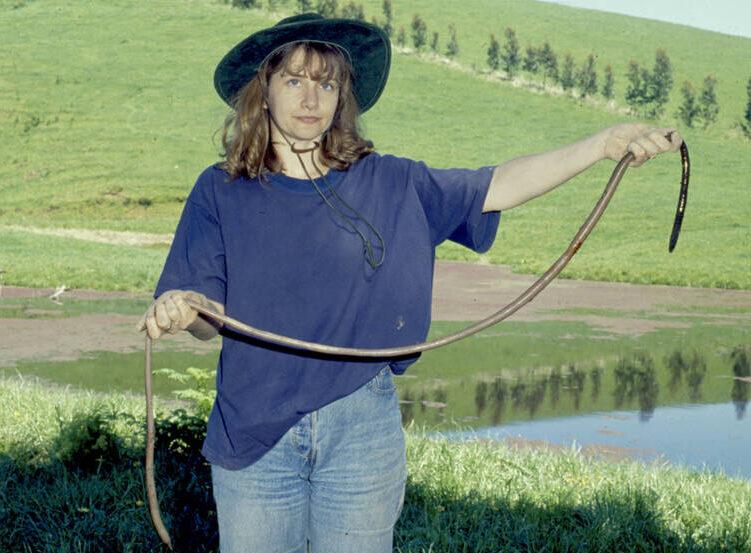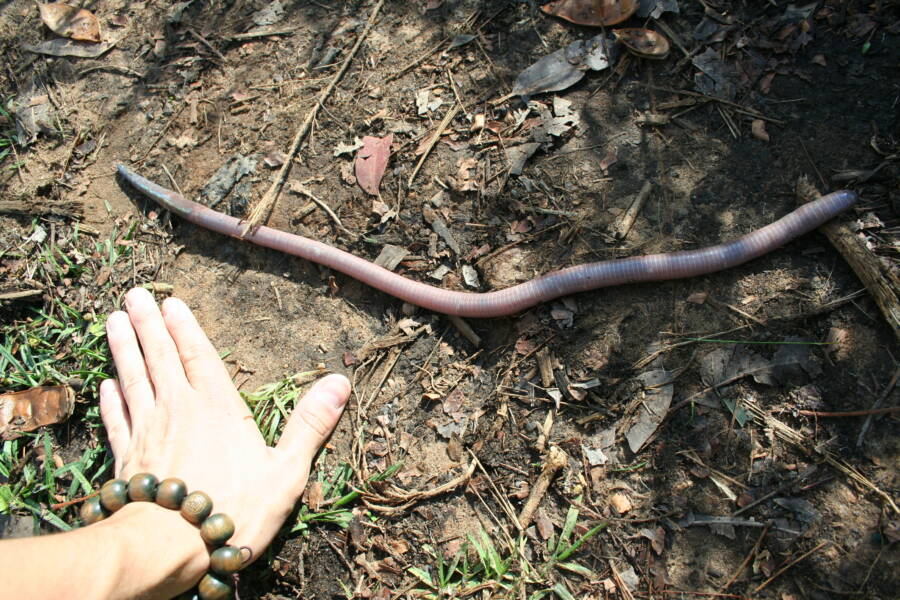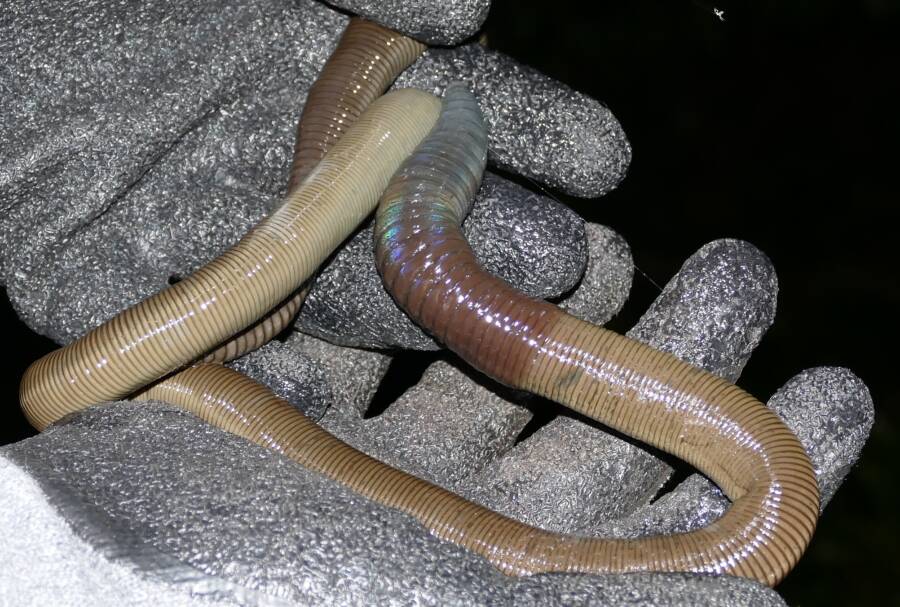A 10-foot monster native to the grasslands of Victoria, the giant Gippsland earthworm may appear terrifying, but it's actually a threatened species whose biggest foe is humans.
From the huntsman spider and saltwater crocodile to the olive python and snake-swallowing frog, Australia is undoubtedly home to some of the world’s scariest creatures. While not quite as terrifying, the giant earthworm has mesmerized millions just the same — as it can grow up to six and a half feet long and is the biggest worm in the world.
Isolated for millions of years, the Australian continent naturally gave rise to an abundance of lifeforms wholly endemic to the landmass to this day.
Fortunately for those who discovered the giant Gippsland earthworm in 1878, the species is harmless to humans — no matter how it appears.

Museums VictoriaBiologist Beverley D. Van Praagh holding a mature giant earthworm.
This slithering behemoth can burrow up to five feet deep — without any limbs. What truly distinguishes the Megascolides australis species, however, is that one can hear it through the soil — as it produces a loud and disturbing gurgling noise that sounds like water draining from a bathtub.
The Discovery Of The Giant Earthworm
The strange beast was first discovered by railroad workers in the Gippsland region of Victoria in 1878. While doing a routine survey of a line there, the baffled crew initially mistook it for a snake. It soon became clear, however, that it was something else — with the men taking it to the University of Melbourne for answers.

Flickr/Kaj17The giant earthworm’s offspring are already one foot long at birth.
Fortunately for them, Frederick McCoy had moved to Australia decades earlier and was an esteemed paleontologist at the institution. The Irish researcher had even founded the school’s renowned Botanic Garden, and was an ideal candidate to classify the specimen, give it a name, and study it in further detail.
As published in the Prodomus to the Zoology of Victoria journal, the study declared this species the largest worm in the world. And while the giant earthworm is far bigger than any of the other 1,000-plus earthworms native to Australia, it has faced the same challenges — exacerbated by its enormous size.

Flickr/Bernard DUPONTThese animals mate underground to avoid predators.
In order to eat, the creature uses its muscle-laden head to burrow into the soil and hoover up any bacteria, algae, fungi, and microbes it can find. Since worms are naturally toothless, the critter uses the tiny rocks it unwittingly ingests to mush up the food it consumes — with its excrement, or castings, sealing up their burrows.
“Many other species of earthworms mate above ground and don’t have permanent burrows,” said biologist Beverley D. Van Praagh, “but giant Gippsland earthworms are very sluggish on the surface and they would be very vulnerable to desiccation and predators if they stayed above ground for too long.”
It is here, entrenched in their burrow systems, that giant earthworms reproduce — and make a noise so loud it confounds the unprepared to this day.
Its Frightening Sound
A traditional worm despite its size, the species lives underground and only surfaces when heavy rainfall threatens to drown it. While the first to hear it were surely baffled by the sound, it is precisely because of the worm’s moist living environment that it makes the distinct racket.
You can hear that noise here.
“Burrows occupied by giant Gippsland earthworms have very wet walls,” Van Praagh said, “so when the earthworms move quickly within their burrows, it makes a gurgling sound that is quite loud and can be heard above ground. The sound is a bit like water draining out of a bath and has been known to terrify the uninitiated.”
Van Praagh has studied the species for more than three decades and believes that its stretchy nature allows mates to reproduce in underground burrows while avoiding predators. Hermaphroditic, they line up beside each other before one delivers sperm from its spermathecae chamber and fertilizes the other’s egg cocoon.
“These worms are fairly flexible, so it’s possible they extend their length to make themselves thinner,” she said, “thereby allowing the two worms to couple side by side within their burrows … [and] mate whenever they meet and then store the sperm, ready for producing eggs whenever conditions are favorable.”
Why The Giant Gippsland Earthworm Is Endangered

Flickr/Andrew NeildGiant earthworms pose no threat to humans, while manmade pollution has endangered the species.
However, a giant earthworm will only produce an egg cocoon once per year. When ready, the sperm recipient moves its egg case outward to gather the genetic material and then stores the invaluable egg in a specifically constructed chamber within the animal’s underground burrow system. Within a year, it hatches.
A foot long at birth, these animals grow at about half a foot per year and have a life expectancy of a decade.
Before farming began to litter the soil with manmade toxins, the creature thrived across Australia’s dense forestry. Today, however, the animal is relegated to a mere 150 square miles at the southernmost part of the continent, with that wise avoidance of chemicals pushing the creature to a precarious conservation status.
In the end, Van Praagh and other defenders of the admittedly unappealing creature hope we treat their soil like we would our own homes — so that the species doesn’t vanish into extinction.
After learning about the giant earthworm, read about the giant isopod — the 20-inch-long “sea cockroach.” Then, learn about the rumored Mongolian Death Worm.





